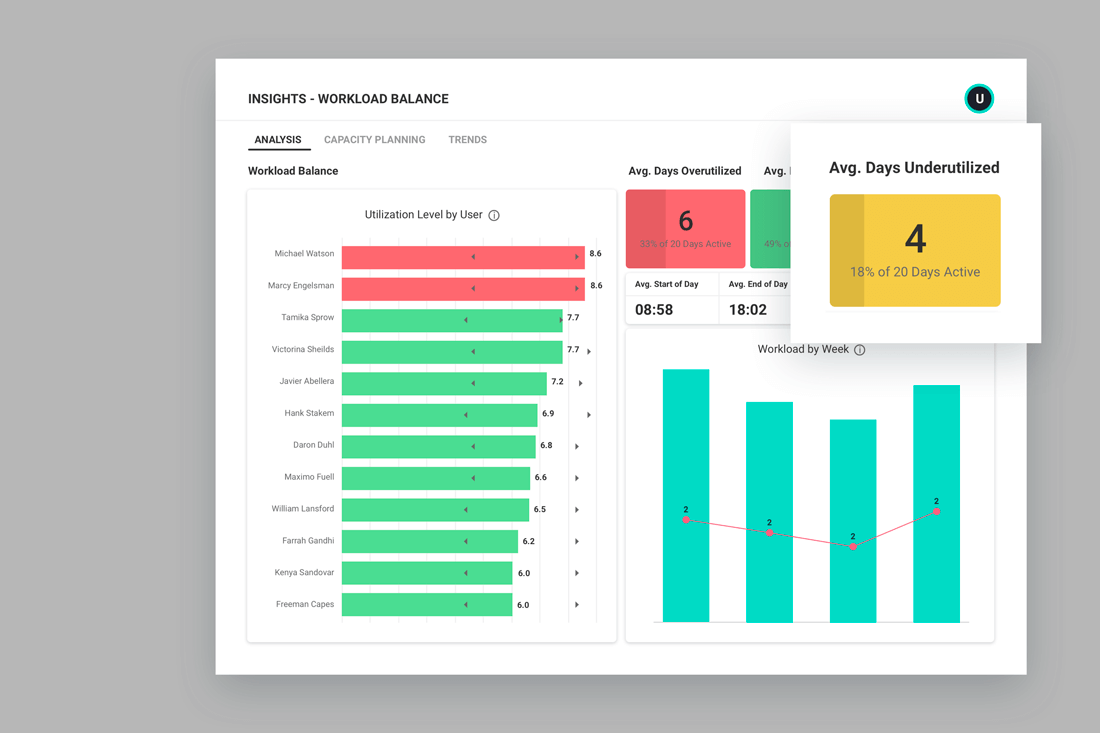In today’s competitive job market, employers must make the most of their workforce. But often, employees work below their full potential — and it happens more often than many leaders realize. Hidden skills and untapped strengths slip through the cracks, leaving team members underutilized and frustrated.
The result is less productivity, missed opportunities and low morale that gradually gives way to disengagement.
The good news? Learning how to spot underutilization empowers you to correct it. In this post we’ll break down what underutilization looks like, why it matters and proven steps for turning overlooked talent into organizational impact.
What is employee underutilization?
Employee underutilization occurs when an individual’s capabilities, experience or potential go unused in their current role, limiting both personal growth and organizational impact.
Common signs include lack of challenge, stagnant development and disengagement. For an example of underutilization, consider an employee who consistently completes tasks prior to deadlines but isn’t given additional responsibilities or challenges. Over time, the stagnation leads to boredom, resentment or even turnover.
Addressing underutilization requires proactive effort on both sides. Employees need to voice their interest in growth and stretch assignments, while leaders must create systems to identify hidden strengths, offer skill-aligned opportunities and ensure roles evolve with individual capabilities.
The impact of underutilized employees
Underutilization significantly impacts employee morale and productivity. When employees feel their skills and potential aren’t put to use, they become disengaged, unmotivated or disenchanted with their work. This leads to decreased productivity, higher turnover rates and a general decline in overall performance of the team or organization.
In a recent Workforce Utilization Benchmarks report from the ActivTrak Productivity Lab, researchers discovered organizations with the greatest underutilization rates waste the equivalent of 1 in 5 workers’ salaries from untapped capacity. And because these underutilized employees frequently exhibit signs of disengagement, their companies face up to 43% higher turnover — and spend 33% of employee salaries to find replacements. In other words…
Organizations failing to address employee underutilization not only miss out on the full potential of their workforce but also risk financial losses.
Signs of an underutilized employee
Some common signs of underutilized employees include:
- Lack of motivation or enthusiasm in their work
- Consistently completing tasks ahead of schedule or with minimal effort
- Expressing frustration or dissatisfaction with their current role
- Seeking additional challenges or responsibilities
It’s important to note these signs alone may not be conclusive proof an employee isn’t fully utilized. However, they’re valuable starting points for further investigation.
Causes of employee underutilization
Understanding why underutilization happens is just as important as spotting the signs. Often, it’s not the employee’s fault — they may want to contribute more but can’t due to systemic or organizational factors.
Common causes of underutilization include:
- Poor role alignment: The employee was hired into a role that doesn’t fully match their capabilities or career interests.
- Lack of visibility: Managers may be unaware of an individual’s full skill set, past experience or untapped strengths.
- Overly rigid job structures: Roles that don’t evolve with business needs or the employee’s growth result in underutilization over time.
- Ineffective resource allocation: High-performing employees may be assigned low-impact tasks while other areas go understaffed.
- Limited development opportunities: Without stretch assignments, mentorship or skill-building programs, employees stagnate.
- Communication breakdowns: Employees may hesitate to express interest in new challenges or feel unheard when they do.
How to find employees who are underutilized at work
There are several ways to identify which employees aren’t used to their full potential at work. Let’s look at several of the most effective methods.
Performance reviews and check-ins
Employee performance reviews provide valuable insights into individual performance and potential areas of underutilization. Regular check-ins and candid conversations with employees also help managers gauge job satisfaction and identify new opportunities to put untapped skills to use.
Surveys
Employee surveys or feedback mechanisms also provide employees with a way to express thoughts, concerns and ideas regarding their roles and development within your organization. However, self-reporting on its own doesn’t provide reliable data for spotting underutilized employees, especially because many employees do not feel comfortable providing completely honest information.
Utilization software
ActivTrak’s workload management software provides objective data on employee utilization, including the ability to pinpoint employees who work faster than expected while still hitting goals. It also helps you spot overworked employees who struggle to keep up. Together, these insights make it easy to balance workloads. Productivity monitoring provides further insight into productivity trends across teams and individuals, allowing you to make adjustments as needed.
Strategies to help underutilized employees
Once you identify underutilized employees, it’s important to implement strategies to help them reach their full potential. Here are six methods to consider:
1. Encourage skill development and training
Offering skill development and training opportunities is a powerful way to support underutilized employees. Provide access to workshops, courses or certification programs to help employees acquire new skills or enhance existing ones. This makes them more valuable assets to the organization. By investing in their professional growth, you demonstrate a commitment to your employees’ development and overall job satisfaction.
2. Redefine job roles and responsibilities
You may notice some employees’ job descriptions don’t match their skills or the tasks they’re completing. It’s a good idea to redefine job roles and responsibilities to better resonate with employees’ strengths and interests. Just because an individual was hired to fill a certain role doesn’t mean they can’t provide value to others. If workloads aren’t distributed evenly, update roles and reassign responsibilities to team members who have the bandwidth and skills to help. Assigning tasks based on skills makes employees feel more engaged and valuable in their roles, which increases both job satisfaction and overall productivity.
3. Offer new challenges to employees
Providing opportunities for employee creativity and engagement drives growth across the entire organization. Offer employees the chance to show their strengths in new ways, such as providing them roles in expansion efforts or new product development.
4. Give employees a chance to teach others
If you notice an employee is particularly adept at a tool or process, offer them the opportunity to teach other employees. Many people jump at the opportunity to show colleagues how to better use the tools available to them. Teaching other employees boosts social clout in the organization as well.
5. Provide mentorship opportunities
Senior leaders often take on more projects than they can handle, but don’t know who to delegate tasks to. Close this gap by creating a mentorship program, which gives senior leaders the opportunity to coach more junior team members. This also increases communication between different levels of staff — if one senior manager notes they need help in an area, another may identify the perfect fit in their department.
6. Promote open communication
Clear and honest communication is the best way to address employee underutilization effectively. Encourage employees to express their thoughts, concerns and ideas freely, without fear of reprimand. Regular team meetings, one-on-one sessions or anonymous feedback all provide employees opportunities to bring up their concerns. From there, it’s up to leadership to actively listen to employees and address their needs, which contributes to an environment that fosters full employee utilization.
Use ActivTrak to identify and support underutilized employees
Leverage productivity and performance software to identify underutilized employees at your organization. Pinpoint high-performing team members who complete tasks quickly and efficiently and reward them with new challenges and opportunities. Quickly spot employees who are adept at technologies or tools and give them an opportunity to train others.
Get a demo of ActivTrak today to see how we help organizations like yours find and support underutilized employees.





